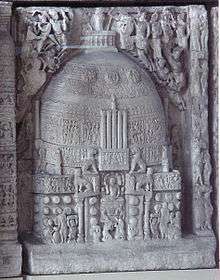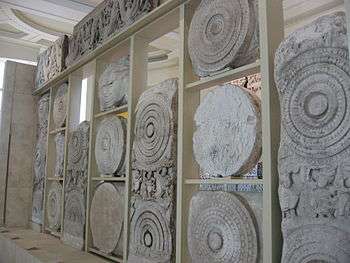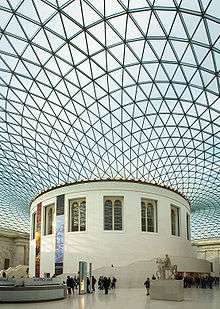Amaravati Marbles
|
The sculptures as displayed in the British Museum. | |
| Material | Limestone |
|---|---|
| Created | 1st century BCE to 8th century CE |
| Discovered | 1797 |
| Present location | British Museum, London |
The Amaravati Collection, sometimes called the Amaravati Marbles, is a series of 120 sculptures and inscriptions in the British Museum from the Amaravathi Mahachaitya in Amaravathi, Guntur in the Indian state of Andhra Pradesh. The Amaravati artefacts entered the Museum's collection in the 1880s. The Amaravati sculptures have also been called the Elliot Marbles on account of their association in with Sir Walter Elliot in the 1840s.
Description
The Amaravati collection in the British Museum consists of over 120 different pieces made from a limestone called Palnad marble; although the material is certainly not marble and the source of the stone in the Palnad quarry not decisively proven.[1]
Most of the figurative sculptures are in relief, with many of the most crowded scenes illustrating stories from the Jataka tales, a large body of literature with complex accounts of the previous lives of Buddha. The collection in the museum in Chennai (formerly Madras) has a large number of sculptures in relief, which they have classified by four periods of activity starting in the second century BCE and stretching to the second century CE. Early interest in the stupa and its sculptures was to some extent because it was wrongly thought to contain early evidence of Christianity in India.[2]
The segments can be divided into a number of categories, including parts of the stupa's toranas or gateways, and the symbolic wall connecting them, and parts of the stone facing of the mound dome of the stupa itself. They include pillars, crossbars and copings, drum frieze panels and slabs, pillar fragments, two guardian lions and a number of miscellaneous pieces, some of which date from later periods. In total, they represent one of the most important collections of ancient Indian sculpture outside the sub-continent.
Early history and documentation in India
After the first explorations of the site by Colin Mackenzie, Sir Walter Elliot of the Madras Civil Service undertook excavations at the Amaravati stūpa in 1845 and transported the excavated pieces to Madras, where they were placed on the greens in front of the College.[3] After enquiries from the Court of Directors of the East India Company, the stones were moved to a slightly less exposed site in front of the Museum. In 1853, the Curator of the Museum, Dr. Edward Balfour of the Madras Medical Service, informed London that the condition of the sculptures was deteriorating due to their situation and in order for the Company to make a decision as to whether the stones were of sufficient artistic importance to merit transportation to London, Balfour arranged for a series of drawings to be made of the pieces by the Indian artist P. Murugasa Moodaliar in 1855. The drawings are preserved in the British Library.[4] Although in general these drawings gave a good idea of the sculptures, Balfour was not entirely satisfied with their accuracy and therefore persuaded Dr A. J. Scott to take a series of photographs, which were also forwarded to London.
In 1858, Linnaeus Tripe made a further series of photographs of the sculptures in Chennai. A set is preserved in the British Library as Photographs of the Elliot Marbles; and other subjects; in the Central Museum Madras (Madras, 1858–59) under shelfmark Photo 958.[5] In the following year, namely 1858, some of the Amaravati sculptures were shipped to London on the orders of the Court of Directors of the East India Company.
Arrival in England
In England, the Amaravati sculptures were destined for the museum of the East India Company. Known as the India Museum, this institution was established in 1801 to house the natural history specimens, books, samples of manufactures, manuscripts and other miscellaneous items collected by the Company and its officers in India.[6] The Amaravati sculptures arrived just as the East India Company was being dissolved, so the sculptures were stored at Beale's Wharf in Southwark before being transferred to Fife House in Whitehall, a building once occupied by James Duff, 2nd Earl Fife (d. 1809). The Indian collections in Fife House were opened to the public in July 1861.[7] Conditions at Fife House were less than ideal and the Amaravati pieces sustained some damage there due to weather conditions. This drew the attention of James Fergusson (1808–1886), who had published a book on Amaravati in 1868 and appears to have expressed his concerns to Augustus Wollaston Franks at the British Museum.[8]
Transfer to the British Museum in 1880
Although several proposals had been put forward in the 1860s to transfer some of the India Museum collections to the British Museum, moves supported by Antonio Panizzi, administrative complexities prevented a speedy decision. In addition, John Forbes Watson (1827-1892), in charge of the India Museum from 1858, was determined to preserve the organization and lobbied energetically for a new building and the creation of an 'Imperial Museum for India and the Colonies'.[9] After several failed proposals, the lease on Fife House expired in 1869 and the India Museum briefly rejoined the library in the newly created India Office. There was so little room that the Amaravati sculpture was sent to the India Office Stores in Lambeth. Some of the India Museum collections were slowly moved to the South Kensington Museum (forerunner of the V&A), where a three-year lease had been taken on some of the galleries there. This move coincided with the appointment of Dr. George Birdwood as the curator at South Kensington. After debates in and out of the House of Commons, Sir Louis Mallet (1823–90) asked Birdwood to prepare plans for the dispersal of the India Museum in 1879. The India Museum was then dissolved and the transfer of collections effected in 1880.[10]
Display of the Amaravati collection in the British Museum
After the sculptures in London were deposited in the British Museum in 1880, for a long time they were arranged on the museum's main stairwell until they were removed for safekeeping during World War II. They re-emerged in the 1950s, but the atmospheric conditions in London at the time caused the sculptures to deteriorate. They were moved to an air-conditioned basement in 1959 where they remained for over thirty years until a special gallery could be constructed.[1]
In 1992, the British Museum's Sir Joseph Hotung Gallery (Room 33) was opened to feature antiquities from east Asia and south Asia. Adjacent to this gallery (Room 33a), the Amaravati collection is displayed in a special room with controlled humidity and air conditioning.[1] The gallery includes a reconstructed section of the stupa railing and a selection of 'drum slabs' that once decorated the exterior of the stupa-proper.[11] The gallery was sponsored by the Japanese publishing concern Asahi Shimbun after whom the space is named.
Catalogues and research
The first detailed study of the Amaravati sculpture was published by James Fergusson in 1868.[12] Just under a century later, the first catalogue of the collection was prepared by Douglas E. Barrett, one time Keeper of Oriental Antiquities at the British Museum, and published by the Museum in 1954.[13] This was followed by Amaravati: Buddhist Sculpture from the Great Stūpa, published in 1992 to coincide with the opening of the Asahi Shimbun Gallery of Amaravati sculpture.[14] The early printed catalogues have been absorbed and surpassed by the British Museum's collections online database.[15]
As the British Museum database emerged, work on the iconography of the early Buddhist art at Amaravati and Ajanta was being advanced by Prof. Dr. Monkia Zin.[16] Meanwhile, the study of the site's history has been led by Dr. Jennifer Howes who has contributed several articles on the subject and pioneered the online publication of Colin Mackenzie's Album.[17] A wider study of the site and its history was published by Akira Shimada in 2013.[18] A work of meticulous scholarship, this monograph provides a detailed re-evaluation of the site itself, the documents in the British Museum and British Library, and the history of early Buddhist art. Shimada's chronology has superseded all earlier attempts to date the phases of Amaravati sculpture and for the first time places the stupa in its wider cultural and physical landscape.[19]
In 2014, The Robert H. N. Ho Family Foundation supported a conference at the British Museum entitled Amaravati: The Art of an Early Buddhist Monument in Context at the British Museum; the papers are currently in press and expect in 2016.[20]
Collaborative research into the Amaravati sculptures is ongoing through the World Corpus of Amaravati Sculpture, a project directed by Prof. Akira Shimada in collaboration with the Archaeological Survey of India. The aims of the project are to 'facilitate access to the site’s sculpture and documentation, to encourage the interdisciplinary and international discussion of Amaravati and to promote new research and publication on Amaravati and Buddhist archaeology.'[21]
Gallery
| Wikimedia Commons has media related to Buddhist art from Amaravati. |
-

Dome slab from the 2nd century stupa.
-

Frieze from Amaravati depicting the stupa.
-

Slab of the Great Stupa with the Buddha standing at the entrance to the monument.
-
Gazelles facing each other.
References
- 1 2 3 Roy, Amit (December 1992). "Out of Amatavati". IndiaToday. Retrieved 21 December 2013.
- ↑ Buddhist Sculptures, Government Museum, Chennai, retrieved 21 December 2013
- ↑ Jennifer Howes, "Colin Mackenzie and the Stupa at Amaravati," South Asian Studies 18 (2002), pp. 53-65. See http://jenniferhowes.com/publications-podcasts-etc/articles--book-reviews.html
- ↑ See British Library Madras Government Collections, 2242-2283; http://www.bl.uk/catalogues/indiaofficeselectpd/BriefDisplay.aspx?SearchType=AlphabeticSearch&ListType=Artist&Value=3674.
- ↑ Photos of the Elliot Marbles, Linnaeus Tripe, British Library, retrieved 19 December 2013.
- ↑ Desmond, Ray. The India Museum, 1801-1879. London: H.M.S.O., 1982.
- ↑ Michael Willis, "Sculpture from India," in A.W. Franks: Nineteenth-Century Collecting and the British Museum, ed. Marjorie Cargill and John F. Cherry (London: Published for the Trustees of the British Museum by British Museum Press, 1997), p. 256; available free online: https://www.academia.edu/2577137/Sculpture_from_India.
- ↑ Michael Willis, "Sculpture from India," in A.W. Franks: Nineteenth-Century Collecting and the British Museum, ed. Marjorie Cargill and John F. Cherry (London: Published for the Trustees of the British Museum by British Museum Press, 1997), p. 256.
- ↑ Michael Willis, "Sculpture from India," in A.W. Franks: Nineteenth-Century Collecting and the British Museum, ed. Marjorie Cargill and John F. Cherry (London: Published for the Trustees of the British Museum by British Museum Press, 1997), p. 257; for Watson, see http://www.vam.ac.uk/content/articles/i/indian-textiles-and-empire-john-forbes-watson/
- ↑ Sir Louis Mallet (1823-90) was an authority on commercial policy and a supporter of free trade doctrine; in 1872 he was nominated to the Council of India; he was Permanent Under-Secretary of State for India, 1874-83, for which see Michael Willis, "Sculpture from India," in A.W. Franks: Nineteenth-Century Collecting and the British Museum, ed. Marjorie Cargill and John F. Cherry (London: Published for the Trustees of the British Museum by British Museum Press, 1997), p. 261, note 39.
- ↑ "History in stone". The Hindu. 28 January 2002. Retrieved 22 December 2013.
- ↑ James Fergusson, Tree and Serpent Worship, or Illustrations of Mythology and Art in India in the 1st and 4th Cent. a. Chr.: From the Sculptures of the Buddhist Topes at Sanchi and Amravati. ; Prepared Under the Authority of the Secretary of State for India in Council ; With Introductory Essays and Descriptions of the (100) Plates (London: India Museums, Allen, 1868). For a review in 1869 see: https://archive.org/details/jstor-3025152.
- ↑ Douglas E. Barrett. Sculptures from Amaravati in the British Museum (London: Trustees of the British Museum, 1954). On Barrett's contribution, see John Guy, Indian Art & Connoisseurship: Essays in Honour of Douglas Barrett (Chidambaram Ahmedabad, India: Indira Gandhi National Centre for the Arts in association with Mapin Pub, 1995).
- ↑ Knox, Robert. Amaravati: Buddhist Sculpture from the Great Stupa (London: Published for the Trustees of the British Museum by British Museum Press, 1992). As pointed out in Mary Stewart (1995), review of Amaravati. Buddhist sculpture from the Great Stupa Journal of the Royal Asiatic Society (Third Series), 5, pp 145-146. doi:10.1017/S1356186300013870 the work is dependent on Barrett and deficient in terms of its knowledge of and relation to Buddhist studies and iconography.
- ↑ https://www.britishmuseum.org/research/collection_online/search.aspx
- ↑ For example Zin, Mitleid und Wunderkraft. Schwierige Bekehrungen und ihre Ikonographie im indischen Buddhism's (Wiesbaden: Harrassowitz, 2006). For a full list of publications and links see, http://www.indologie.uni-muenchen.de/personen/2_professoren/zin/index.html
- ↑ Howes, "Colin Mackenzie and the Stupa at Amaravati," South Asian Studies 18 (2002), pp. 53-65, and Howes, "A Colonial History of Sculptures from the Amaravati Stupa," in Buddhist Stupas in South Asia, ed. J. Hawkes and A. Shimada (Delhi, Oxford University Press, 2009): pp. 20-39. For online links, see http://jenniferhowes.com/publications-podcasts-etc/my-books-articles--book.html
- ↑ Akira Shimada, Early Buddhist Architecture in Context: The Great Stūpa at Amarāvatī (Ca. 300 BCE-300 CE) (Lieden: Brill, 2013).
- ↑ The book has been extensively reviewed: Claudine Bautze-Picron, Arts Asiatique, 68 (2013), 158-159; Peter Johansen, Asian Perspectives, 52-2 (2013), 368-371; Robert Brown, South Asian Studies, 30 (2014), 278-279. Upinder Singh, The Book Reviews, 39-6 (2015), 12-13.
- ↑ For a list of papers see: https://www.academia.edu/13646343/Amarāvatī_The_Art_of_an_Early_Buddhist_Monument_in_Context
- ↑ http://www.basas.org.uk/site/index.php/our_work/page/689aaf33-c326-4090-a60d-dc6950adffa5/
Further reading
- Barrett, Douglas E. Studies in Indian Sculpture and Painting. London: Pindar Press, 1990.
- Shimada, Akira. 2006. "The Great Railing at Amarāvatī: An Architectural and Chronological Reconstruction". Artibus Asiae. 66, no. 1: 89-141.
- Zwalf, Wladimir. Buddhism: Art and Faith. London: British Museum Publications, 1985.

